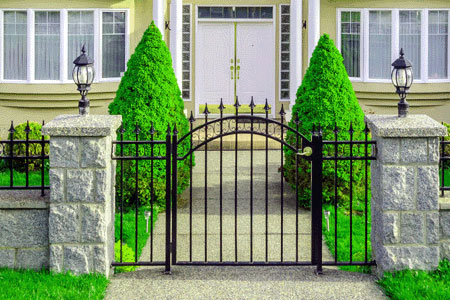
Every property seller must remember that home staging a fence is just as important as enhancing any other interior or exterior real estate feature. In fact, since some fences are clearly visible when first viewing the house from the outside, improving the aesthetics of the fence is an inherent aspect of optimizing curb appeal.
Residential fencing comes in a wide range of styles, sizes, colors and other options. However, it is crucial to remember that regardless of the type of fencing utilized, the condition must be excellent and the barrier must be functional, as well as beautiful.
This guide helps property sellers to augment the value of their houses by providing easy tips geared towards fence home staging.
Home Staging a Fence Options
When it comes to fences, there are 3 strategic options that can be used during the home staging process:
Fences can be taken down and the property left without any barriers around the yard. This might be a good solution when the yard does not require a barrier and the current fencing is old, damaged or ugly. Just remember that when removing a fence, without replacement, the yard will require some repair work to be done, in order to fill post holes and to balance the landscape design. Depending on the amount and extent of yard fixes that need to be accomplished, it might be easier just to install a new fence to take the place of the old removed barrier.
The second option is to replace an old worn fence with a brand new one. This is the most common solution for problematic fences, since it is easy and does not require much time or effort on the part of the homeowner. Property owners can do this job themselves in some cases or can elect to hire a fencing company to take care of all the hard work for them.
The last option is to install a fence, even though no fence was ever placed previously on the property. This is a great fix for properties that should feature barriers, but have not had the benefit of fencing in the past. We usually only recommend installing a new fence when there is an unsafe condition on the property, such as an unprotected swimming pool or access to public land bordering the property.
Home Staging a Fence / Materials
Residential fencing comes in several distinct styles and materials. The most common options in fencing include all of the following choices:
Split rail fencing is a budget-friendly option that is easy to install by virtually any homeowner. Split rail designs are best suited for aesthetics only, since they do not provide actual barrier protection for a yard, unless the fence is reinforced with chain link or chicken wire. Split rail fences fit well with rural aesthetics, but look out of place with many other styles of homes.
Vinyl fencing is the most modern style and comes in a wide range of sizes, options, colors, and patterns. Vinyl is pricey, but also lasts for a very long time without requiring maintenance. Vinyl fences are buyer favorites and add the most value to virtually any type of property. If I had to recommend one type of fencing to replace all others, my choice would be vinyl every time.
Chain link fencing is inexpensive and easy to install. If an old fence is being replaced and the poles are still useable, then simply adding new chain link is one of the simplest fencing solutions. Vinyl covered chain link is preferred over simple metal link, since it resists rust. Chain link is not a popular style with buyers, however, since it looks industrial and does not provide privacy, unless it is further reinforced with opaque slats.
Stockade fencing is made of wood and is also budget-friendly for many uses. Stockades can be made in many styles and sizes. Stockade fencing provides privacy and security, but only boasts moderate durability. Furthermore, it requires considerable maintenance in terms of regular staining or painting, as well as the need to repair cracks and board breaks.
Iron fencing is usually the most expensive and is therefore often reserved for high-end properties. Iron fencing is available in many sizes, styles and colors. It can provide excellent security, but does not provide privacy and may not adequately contain small animals. Some iron fences are almost maintenance free, while others require regular care, including paint or clear lacquer application. Steel and aluminum also can be used to create the appearance of an iron fence, without all the maintenance requirements.
Plastic mesh fencing is almost exclusively used around pools and other water features on a property. These fences are light duty and only meant to keep small animals and children from accessing the pool. Mesh fencing does not have to be permanently installed and some styles can be removed easily for entertaining.
Likewise, plexi-glass fences can be used to surround pools, terraces, patios and other property features. Plexi-glass requires frequent cleaning, but is virtually indestructible. It is costly, however, since it allows an unobstructed view from both sides, which can be an asset or a liability, depending on application.
Concrete block fencing is super strong and highly versatile. Concrete walls can be built to any specification and are perfect for a truly customized look. Concrete is perfect for privacy, durability and security, but they can be expensive to install. However, many homeowners can build their own concrete walls with some basic tools, lots of manual labor and a bit of research.
Home Staging a Fence Fixes
Replacing fencing can be expensive and a difficult task for DIYers. Therefore, if you are trying to sell your home and wish to simply fix up the fence you already have, we recommend the following solutions:
Be sure the poles are sound and straight. Re-footing poles using fresh concrete can help to fix problems with fence infrastructure.
Many fences can be easily replaced by reusing the same poles and simply changing the connecting material. This makes replacement less expensive and easier for a homeowner to do themselves.
Wood fences can be improved by simply replacing worn pieces or sections, while leaving other areas alone. Stockade and split rail fencing can be fixed simply and cheaply in most cases.
Wood fencing can also be renewed by repainting or re-staining the surfaces. This is a labor-intensive job, but can be contracted out to virtually anyone, for minimal investment.
Chain link can be patched, although this might look unappealing. Older, but decent condition chain link can be refreshed by adding new opaque slats or filler materials to camouflage any unaesthetic sections.
Damaged vinyl fencing can be repaired using high-tech patch kits or by contracting a fence installer who specializes in fixing vinyl materials.
Iron fencing can be painted for an easy fix. Rust should always be removed first and the area treated to ensure that the paint will adhere.
Regardless of the type of fencing installed, be certain that all gates open and close correctly. Replace any defective hardware with a new component part.
Any marks or graffiti on fencing can usually be removed with a professional-grade power washer. These can be rented for a few dollars from most major home stores. Alternately, the homeowner can hire a fence cleaning service to powerwash many areas of the exterior property for a renewed appearance all around.
Sometimes, the easiest way to fix a fence issue is to change the landscape surrounding the problematic area. Fences with bottom gaps are usually easier to address by adding soil to the yard, rather than re-configuring the fence itself. Likewise, adding new landscaping features, such as flowers or shrubs, can hide many fence flaws, as long as the are not real deal-breakers that exist in prime locations.
Home Staging a Fence Summary
I hope that this essay helps to provide all the details needed to make those necessary improvements on your fencing, before listing your home for sale. Remember, always complete your total home staging plan before listing the house on the competitive real estate market, in order to reap the full benefits of your investment of time and money.





